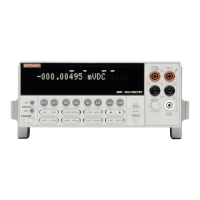IEEE-488 Reference
4-30
<NRf> Numeric representation format: This parameter is a number that can be ex-
pressed as an integer (e.g., 8), a real number (e.g., 23.6) or an exponent
(2.3E6). Example:
:SYSTem:KEY 16 “Press” NEXT key from over the bus.
<n> Numeric value: A numeric value parameter can consist of an NRf number or
one of the following name parameters; DEFault, MINimum or MAXimum.
When the DEFault parameter is used, the instrument will be programmed to
the *RST default value. When the MINimum parameter is used, the instru-
ment will be programmed to the lowest allowable value. When the MAXi-
mum parameter is used, the instrument will be programmed to the largest
allowable value. Examples:
:TRIGger:TIMer 0.1 Sets timer to 100msec.
:TRIGger:TIMer DEFault Sets timer to 1sec.
:TRIGger:TIMer MINimum Sets timer to 1msec.
:TRIGger:TIMer MAXimum Sets timer to 999999.999sec.
Angle brackets < >:
In this manual, angle brackets (<>) are used to denote parameter type.
Do not
include the brackets in the program message. For example:
:SOURce:TTL2 <b>
The <b> indicates that a Boolean type parameter is required. Thus, to set digital input line
#2 true, you must send the command with the ON or 1 parameter as follows:
:SOURce:TTL2 ON or :SOURce:TTL2 1
2.
Query commands:
This type of command requests (queries) the currently programmed sta-
tus. It is identified by the question mark (?) at the end of the fundamental form of the com-
mand. Most commands have a query form. Examples:
*OPT? Common query command.
:TRIGger:TIMer? SCPI query command.
Most commands that require a numeric parameter (<n>) can also use the DEFault, MINi-
mum, and MAXimum parameters for the query form. These query forms are used to deter-
mine the *RST default value, and the upper and lower limits for the fundamental command.
Examples:
:TRIGger:TIMer? DEFault Queries the *RST default value.
:TRIGger:TIMer? MINimum Queries the lowest allowable value.
:TRIGger:TIMer? MAXimum Queries the largest allowable value.
3.
Case sensitivity:
Common commands and SCPI commands are not case sensitive. You can
use upper or lower case, and any case combination. Examples:
*RST = *rst
:SCAN? = :scan?
:SYSTem:PRESet = :system:preset
4.
Long-form and short-form versions:
A SCPI command word can be sent in its long-form
or short-form version. The command subsystem tables in this section provide the com-
mands in the long-form version. However, the short-form version is indicated by upper case
characters. Examples:

